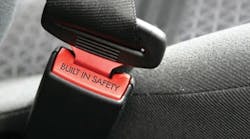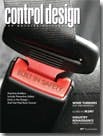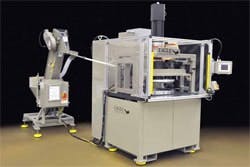Machine safety must be more than an afterthought.
In the old days, machines were built, and guards and other safety features were added later, which wasn't very efficient. More recently, many builders make safety an integral part of their design process, and new safe-speed and zone-control technologies and harmonizing international standards are helping them. And, not only does this proactive, preventive approach reduce the frequency and severity of potential accidents and injuries, it pays added dividends of increasing machine efficiency and reducing downtime.
SEE ALSO: Mainstream Machine Safety
Jim Montague is the executive editor for Control. Email him at [email protected].
"Validation of safety systems is a process that needs to be planned," says Steve Zuberbier, engineering technical leader for family care R&E at Kimberly-Clark, which makes Huggies, Kleenex, Scott, Kotex and other products. "If you don't plan, you will fail. Will validation cost your company more effort? Yep. Will it cost you more time, resources and money? Yep. But, we've seen our safety validation effort pay for itself over and over again."
Zuberbier adds that safety problems occur because of people. "My safety controller will perform consistently," he says. "My humans will not. Using an engineered, controlled system provides a more reliable safety solution and keeps our people safe. The effort it takes to validate a safety PLC is much greater than it was with the old hardware relays because we didn't have to worry about programming the I/O points. However, we haven't bought a single machine since 2007 that doesn't have a safety PLC system. And, we've taken validation from 48 to 72 hours down to six to 12 hours now."
Savings Go With Safety
Similarly, Automatic Handling International (AHI) in Erie, Mich., makes roll-handling and packaging machines for tissue, non-woven materials, converting and other applications, and it recently began designing and integrating more safety capabilities into its equipment to eliminate hazards, but also to drive costs out of its engineering and manufacturing processes by getting them to work together in a more integrated fashion.
"We were still doing hardwired safety in 2007, but these are big systems, and so the question was how to protect everything because you might not know where everything is," says Dan Pienta, AHI's president. "What are the zones going to be? Who's going to enter those zones? What do we want to keep safe? We learned how to do a good process to work with a hardwired safety system, but it was a challenge because every system was different — everything was custom."
Pienta reports AHI moved to DeviceNet when Rockwell Automation launched its GuardLogix controls, which combined PLC and safety communications in one device and used the same network, but maintained two separate microprocessors. Later, AHI adopted EtherNet/IP when that protocol offered integrated safety, and standardized on GuardLogix and Safety Point I/O.
"It can be a tough transition to implement a new technology," Pienta explains. "I might not be sure how to implement in a way that I might need for the future, so you have to kind of feel your way through it. It's not that safety is so complex, but we do 100 projects per year. Safety is a small part of our business, but it impacts every part of it. So, when safety on Ethernet came out, it made a lot of sense because it allows us to use standard hardware and stay flexible, but also give our customers the most reliable systems. Safety has to be part of what you sell because it can help customers be more productive, reduce risk and add value."
Update the Attitudes and Cultures
No doubt, the biggest roadblock to integrating safety into machines, production lines and plants is changing the minds of managers and operators from the old belief that safety is a drag on operations and the bottom line to a new belief that safety is a doubly worthwhile investment than can be profitable and prevent injuries and accidents.
For example, research by the Aberdeen Group shows there are clear correlations between success in reducing injury rates with reducing unscheduled downtime and much higher overall equipment effectiveness (OEE) levels. Its studies found that best-in-class performers had 5-7% higher OEE, 2-4% less downtime, and less than half the injury rate, according to Steve Ludwig, Rockwell Automation's program manager for safety.
However, altering the old, safety-is-a-burden mindset can be devilishly hard. "I grew up in automotive plants, so I'm aware that safety and productivity have been at odds," says George Schuster, senior industry specialist on the automotive team at Rockwell Automation. "They knew the more safety processes they put on their systems, the more they'd hinder their productivity or profits. They knew it. It was almost in their DNA."
More recently, the productivity and safety ropes seem to be pulling in the same direction. A December 2012 Control Design survey on machine safety found that, besides wanting to prevent personal injury or meet regulatory requirements, machine builders most often would change their safety implementation because of potential lost production on the machine. In fact, about 90% of those surveyed list the prevention of personal injury as the key reason for changing safety on their machines, which was higher than the 75% that make a change to meet regulatory requirements.
"The people who establish corporate cultures are less and less conflicted about productivity and safety than they've been in the past," Schuster adds. "Safety is a tool that machine builders use to improve productivity and yield. It's a huge differentiator."
Simplicity Gets to Safety Sooner
Two of the main forces enabling safety to be added to machine designs earlier are controllers that combine safety and control functions, and fieldbuses and Ethernet networks that require less cabling and connectors.
SEE ALSO: Machine Safety Incorporates Relays, PLCs, Risk Assessment and Standards
Pienta adds that AHI cut the time it takes to build and finish its roll-handling and packaging systems by using Ethernet, and combined control and safety components. "We're not wiring as many distributed I/O and other connections back to the main panel," Pienta says. "It's all going to the GuardLogix. When you have fewer connections, it takes less time when you power that panel up and start doing your I/O checks. That has a lot of value. We also get value from safety validation, making sure our safety system works and documenting it. We want to show the insurance guys that we've done our due diligence, and that our systems are as safe as we can make them. This lowers our risk and reduces our liability."
Similarly, Eagle Technologies in Bridgman, Mich., needed to reduce waste and improve the safety capabilities of its spin/friction-welding machine for plastics, especially the fluid-filled, 2-ft-diameter, plastic rings that balance loads in washing machines (Figure 1). The rings are made from two parts — one held in place, while the second is spun and pressed down onto the first, creating a leak-proof weld in less than 30 seconds.
However, one appliance parts maker was experiencing 15% material waste and scrapped parts from leaky welds, while its welders' low-speed, high-torque process strained their motors so much that they needed annual rewiring. The welders had to be powered down and handle 480-Vac drops every 4-5 minutes, so their operators could reach in to remove parts and make needed adjustments.
Eagle's spin/friction welder redesign began with IndraMotion servo platform, which uses Ethernet-based sercos III to integrate the machine's motion logic control directly in the drive without a separate PLC. This motion and logic controller from Bosch Rexroth works with its digital, intelligent servo drives and synchronous servo motors to drive the spin/friction welder's three-stage, planetary gearbox, which allows less-stressful, low-speed, high-torque motion of the welding head on its ballscrew and rails.
In addition, Eagle employed Bosch Rexroth's Safety on Board, which embeds programmable, safety-based logic directly in the servo drives to eliminate the need for the lock-out/tag-out stoppages that were straining the motors, but without requiring external safety hardware. Operator protection is further built into the welder by servo drives that respond to signals from its light curtain via dual, redundant safety channels that put the machine into one of two pause modes — Controlled Stop 1 or Controlled Stop 2 — which stop its motion, but still feed power to it, and allow easy restarts without complete resets.
"Usually a weld machine design starts with a PLC, and then the designer builds out from there," says Earle Cooper, Eagle's project manager. "IndraMotion let us start with control of two axes already built into the servo drive, so we could focus on options for creating different types of welds and parts." He adds that scrap material from the end user's balance ring application dropped from 15% to less than 1%, and productivity was maintained at less than 20 seconds per ring, while the safety system conforms to EN954-1, Category 3, and supports new ISO 13849 standards. "We still don't know exactly how much longer the motors are lasting than before because none have required any repairs," Cooper remarks.
In Software, On the Network
Beyond aiding individual machines and production lines, safety principles and tools created and deployed in software also can be integrated onto different machines, and even scaled up to entire facilities and multi-plant organizations.
For example, Baader-Johnson in Kansas City, Kan., builds machines for processing and conveying poultry, fish and other meats, and uses PC-based controls and integrated safety tools from Beckhoff Automation. Baader-Johnson deploys an embedded PC, and then connects distributed EtherCAT safety I/O terminals, with integrated TwinSafe safety PLC, to manage safety tasks at its clients' plants, while also adjusting safety zones by using TwinCAT as its standard TwinSafe programming tool.
"TwinSafe helps us implement safety functions for e-stops and in other areas," says Ryan Foltz, sales project manager at Baader-Johnson. "On plantwide projects, it's beneficial to use EtherCAT terminals as the standard I/O system, but TwinSafe makes it possible to shut down our machines and conveyors very quickly if anyone on the plant floor enters an unsafe part of the machine. Our former e-stop methodology was rather cumbersome, especially in large applications. TwinSafe cuts down on wiring, and provides the flexibility to properly manage our safety implementations."
Also, Teepack Spezialmaschinen, Meerbusch, Germany, says its new Perfecta tubular teabag filling, bagging and packaging machine (Figure 2) runs a variety of products at about 400 bags per minute with thread and label or with paper or foil packets. It achieves this 20% boost in its performance by combining IndraMotion for Packaging software with decentralized servomotor and controls, sercos III networking, Safety on Board software and an IndraMotion controller from Bosch Rexroth.
In fact, Perfecta even runs automatic, online safety tests in the background to create performance prerequisites for its continuous 24/7 operating schedule. To perform this job, Safety on Board uses several certified safety tools, such as safe stop/operation stop and safe movements in the form of reduced speed, maximum torque or turning direction. These tasks run directly in the drive, which shortens their reaction times to less than 2 msec, according to Teepack, while other safety solutions have to interrupt a machine cycle for coercive dynamization of up to eight hours to detect "dormant bugs."
"We can activate the additional modules and necessary servo drives on the respective machine via the user interface. This reduces the variety of the software and allows quick, subsequent integration of additional modules," adds Andreas Meyering, Teepack's head of electrical engineering and software development.







